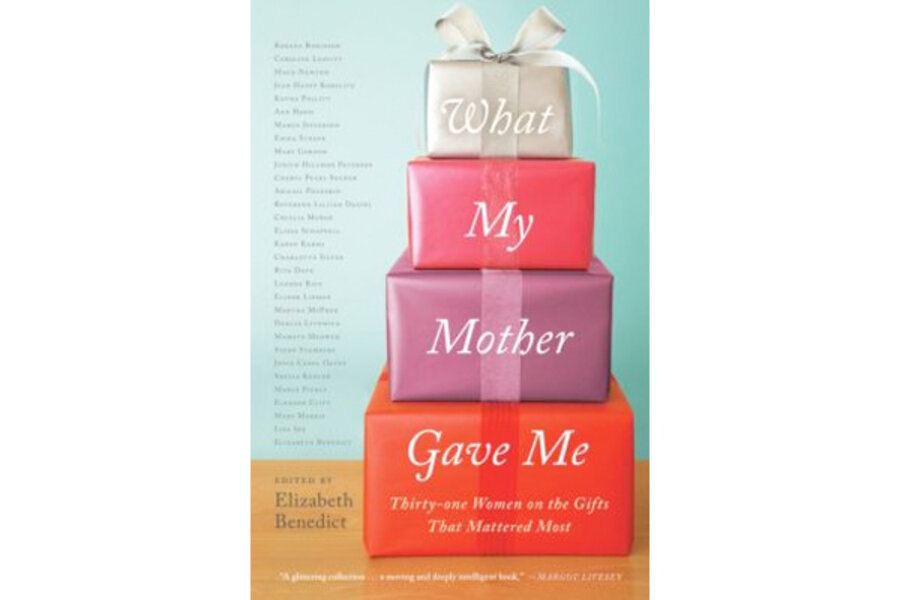What My Mother Gave Me
Loading...
What's the most meaningful gift your mother gave you? That's the question novelist and editor Elizabeth Benedict asked 30 women writers. Their responses, collected in What My Mother Gave Me, provide a beeline into the heart of mother-daughter relationships.
The prized gifts range from the material to the ethereal, the straightforward to the symbolic. Almost all are ultimately instructive, conveying the sort of life lessons rarely delivered in fancy wrapping. They include a salvaged front door that provides a perfect portal to a warm homelife; a sickly plant that delivers lessons about parenting and patience; a life-changing first trip abroad; and money for an interfaith wedding the mother wouldn't live to see, carrying with it her implied blessing.
Not all of the mother-daughter relationships in "What My Mother Gave Me" are close ones, and dismayingly few of the contributors' parents had happy marriages. Many were marred by alcoholism. But the stories these daughters tell about how a scarf, a Buddha, a jade necklace, or a tourist cruise led to deeper understanding and appreciation even for deficient mothers are mostly heartwarming, rather like more polished versions of Dave Isay's Story Corps narratives.
Benedict opens her anthology on an upbeat note, with novelist and biographer Roxana Robinson's tribute to her generous, trusting mom. A polio survivor with an indomitable spirit, Robinson's mother "believed that children were driven by deep yearnings, and that those should, if possible, be satisfied." She indulged her daughter's "heart's desire" for a horse, buying her a red chestnut mare when she was 12 and trusting her to take care of it.
Ann Hood, whose most recent novel is "The Obituary Writer," recalls a gift she detested: an all-white pantsuit. It was an abomination for a girl who cringed at her mother's predilection for matching outfits and elaborate decorations for every holiday. Yet when Hood finally screwed up her nerve to say thanks but no thanks, her gratitude for her mother's gracious reaction is palpable. By acknowledging their differences, Hood comments, "she gave me permission to go into my own mismatched future. What a gift."
Not surprisingly, several essays focus on clothes. Cultural historian Margo Jefferson is grateful for her stylish mother's example in navigating fashion and teaching her to use it as "armor" to help shield herself from a sense of exclusion and inferiority as a black woman.
Charlotte Silver's mother, a famous restaurateur whom she profiled in her memoir, "Charlotte au Chocolat," dresses in a distinctive, flamboyant mix of tulle skirts, high heels, violet lipstick, and enormous Chanel sunglasses, "her badges of feminine armor against the world." Silver says that hand-me-downs – including lots of leopard prints, her mother's "favorite neutral" – make her feel empowered, protected, and close, "as though I were wearing my mother's skin."
Coming at maternally provided security from another angle, Joyce Carol Oates declares, "There is nothing so comforting as wearing clothes your mother has sewn or knitted for you." She notes that many of her book jacket photos were taken in blouses, dresses, and jackets made by her mother. Poet laureate Rita Dove recalls how, in letting her paint her nails "my own way" – in the stripes and polka dots she still favors – her mother helped her become her own person.
Several women appreciate their mother's example in accepting imperfection. Elissa Schappell, author of "Blueprints for Building Better Girls," finds in a scratched cake pan a reminder of her mother's insouciant attitude toward culinary disasters: "That's how they do it in France," she advised her daughter to blithely tell guests. Reverend Lillian Daniel treasures a broken vase her mother valued, which taught her "to learn to see the beauty, the image of God, in broken things, and to call them precious."
Some essays read like eulogies, others like apologies. There's more nostalgia than bitterness on display, for as Marge Piercy comments, "I don't think missing a mother ever stops." Among the more compelling stories, Caroline Leavitt, Karen Karbo, and Sheila Kohler each write of the gift of empathy that follows the belated discovery of heartbreaks from their mothers' pasts.
Martha McPhee, whose latest novel is "Dear Money," again captures the rush of high-stakes risk in a lovely tale about a New York real estate gamble facilitated by her plucky mother's can-do attitude – a woman who "remade herself" after a divorce and taught the fourth of her five daughters "to take the impossible in stride."
In case you're wondering, "What My Mother Gave Me" would make an excellent Mother's Day present, which, one suspects, is what it was conceived to be. What mother wouldn't appreciate the underlying message that one of the greatest gifts she can bestow on a daughter is encouragement to follow her own stars?
Heller McAlpin, a frequent contributor to the Monitor, reviews books regularly for NPR.org, The Washington Post, The Los Angeles Times, and The Barnes & Noble Review.








